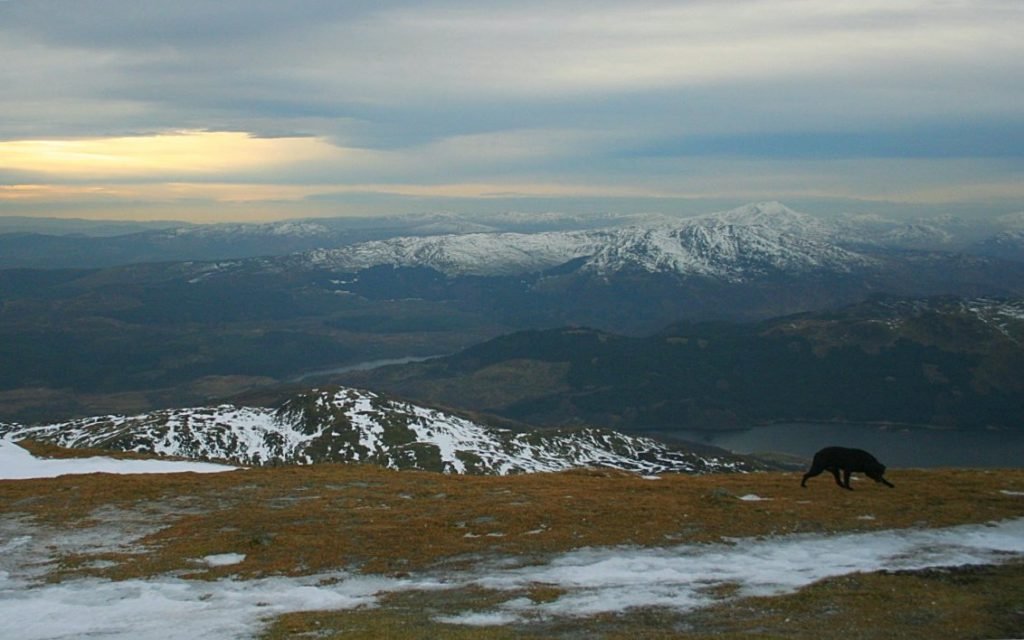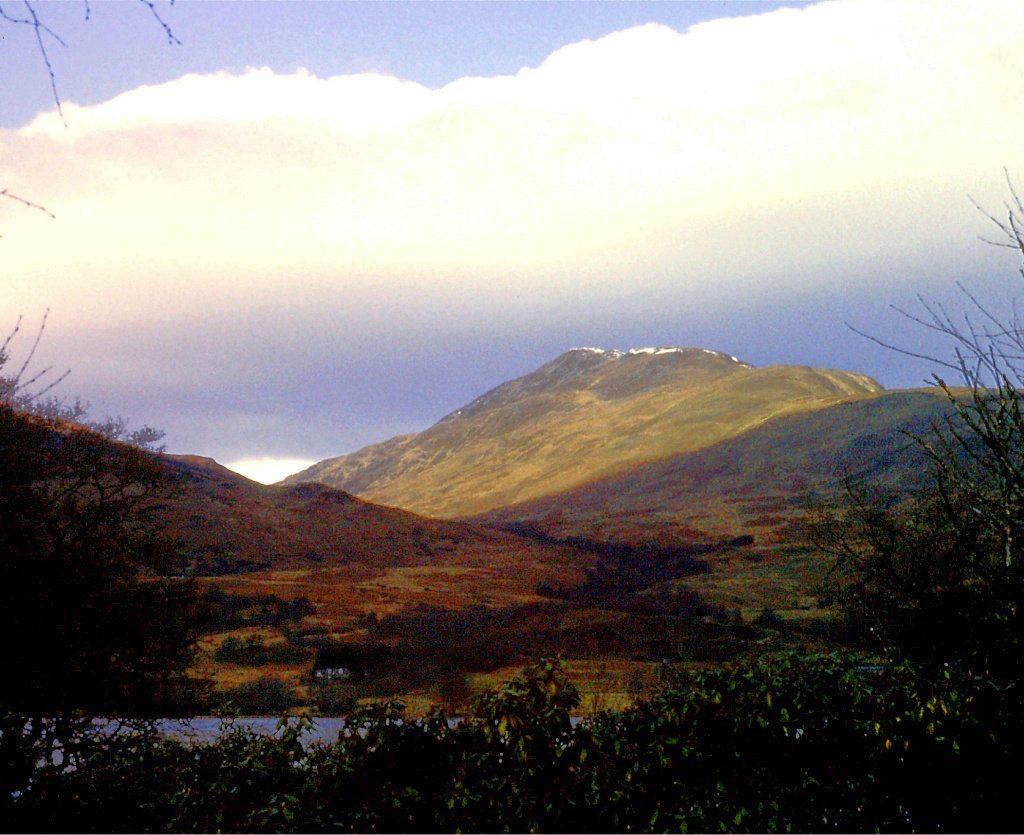Ben Ledi is a conspicuous landmark on the very edge of the Highlands, above Callander. It’s a great day out. Good footwear and chocolate are recommended. Do not treat as a stroll though!
This is one of the most distinctive of Scotland’s hills. At 2884 ft / 879m Ben Ledi isn’t a Munro, it’s a Corbett. More to the point, it sits right on the edge of the Highlands and is conspicuous from many parts of central Scotland.
You can see it as you drive across the Forth Bridge, for example, and from the ramparts of Edinburgh Castle too.
Lace up those boots
Here’s a piece about a winter day on the hill. Lace up your boots……
Off to Ben Ledi in the Trossachs, beyond Callander, near Stirling, in deepest January. As we start the walk, I reflect that paths change but the bones of the mountain remain the same.
Then I further reflect that I sound like one of these tedious walking correspondents with their earnest instructions to take care on the slippery tree roots and turn right at the double kissing gate. (Double kissing, eh? No time for that sort of frivolity – I’ve a hill to climb.)

Not quite the dawn start we’d intended…
The starting point for the walk is the carpark signed off the main A84, north of Callander. It is built on a section of the old trackbed of the Callander-Oban railway (closed 1965).
On the day in question, the carpark was almost full and we felt a bit sheepish leaving at noon, though we felt better after another party of local walkers set off moments before us.
As they passed, one remarked ‘Aye, these dawn starts get to you after a while…’ Odd sense of humour, sometimes, we Scots…..
Hmm…the path is a lot better now
Having been on the hill several times before, at the start I recalled there used to be a very dull, steep, claustrophobic, tree-smothered, view-less, muddy path for the first section after the carpark by the River Teith. Apparently that was a very long time ago.
Now it’s a well-made surface, drained and neat, with rock steps on the steep places, and it takes you well above the tree line.
The other surprise was the sheer numbers of people – on a grey, still, winter Saturday – who decided to get some exercise in this landmark hill on the Highland edge.
And, dammit, they’d all set off ahead of us…

(Above) The late Fergus Smith, who was a full-time Labrador all his life and belonged to a friend, is seen above (right) pretending to be a bear – at least, that’s what I think he looks like – on a winter’s day on Ben Ledi.
(Labrador: ultra-efficient, non-discriminating, food vacuum cleaner.)
Time Needed To Climb Ben Ledi
It should be quite a bit less than three hours to get to the top, allowing for photo stops, sandwiches, general dawdling and that incessant ferreting in rucksacks for extra layers, gloves, hats etc – just a feature of winter walking in Scotland.
The route is basically a pull up on to the ridge at a low point to the south, then a change of direction northwards over a series of knolls, one of which – at last, at long last – is the top.


(Pictured here) Ben Ledi sunset. View to Ben More and Stobinian, on midsummer night. Compare with picture above, taken from same point. A mere 26 years separates the two images, the sunset pic long pre-dating digital photography.
Ben Ledi And The Beltane Connection
Ben Ledi has an old association with Beltane, the ancient Celtic fire ceremony that celebrated the coming of summer on the 1st of May.
Beltane, from Be’uill an early Celtic sun god, goes much further back than the Christian practices that all but subdued it.
It signified the start of the warmer time of year – hence sun, fire and fertility. It was all part of Scottish culture back then.
The fires of Beltane
And it was perhaps Ben Ledi’s conspicuous position on the Highland edge that made it a chosen place for gatherings connected to Beltane, and the lighting of Beltane fires.
Young folk from all around would gather on the hill to greet the dawn on the 1st May. (How the local ministers would have thundered their disapproval from the pulpit of many a dreich kirk!)
Several activities went on after the dawn came up on Ben Ledi and other high hills. The kindling of fire was an important part of the rituals.
Sometimes cattle were driven between fires as a kind of purification and protection. The household hearths in the glens below would be rekindled from the hilltop fires.
Bannocks (oatmeal mixed with egg and milk) were cooked and ritually eaten and there was whisky and beer aplenty. It all sounds great fun. Plenty more detail from, for example, early travellers such as Thomas Pennant. He toured Scotland in 1769.

The hill is also a popular excursion for a midsummer, 21st June, gathering as well. I suspect this is a folk-memory of the 1st May celebrations, only moved to midsummer, but this is just speculating.
The sun goes down on that midsummer night in the notch between the summits of the big hills of Ben More and Stobinian, to the north-west.
Just for information, and I hope this isn’t confusing, I have put in here a midsummer night photo I took long ago, using a moderate telephoto lens.
Anyway, it’s a good place for a quite demanding but not too long high-level walk at any time of year. (The usual ‘take care’ noises certainly apply in winter. It was seriously slippery on top on the day illustrated here.)
Wildlife on Ben Ledi? Not so much…
Because of its popularity, it’s not the best place to see a load of wildlife. We were examined by a patrolling raven several times, but we pointed out that as we had Labradors in the party, the chances of any food scraps being overlooked were zero.

But the panorama was worthwhile. I remember on another trip here seeing Goat Fell on the island of Arran – just one of many landmarks you can identify from this spectacular viewpoint if the conditions are right.
Och, there I go, sounding like a pompous walking correspondent again……
You’ll find another short day but high level excursion on the Creag Leacach page. (Where? Yes, agreed…not one of Scotland’s most famous landmark hills. But a grand day out in the Grampians nonetheless.)
Kirkton Glen above Balquhidder is another good walk.
Here’s a decent and serious description (ie not mine!) of a route up Ben Ledi – with a different return option.